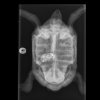I took Roland to work today to use him for xrays. We are tweaking our technique charts and I needed an exotic animal to work on. Check out his xray. I had no reason to xray him other than for practice. It has to be a pile of rocks I think? He has had no access to pebbles since i've had him (4 months). Could they have been ingested before and are just sitting there? My other thought was kidney stones maybe? Despite being a vet tech, I know very little about tortoise anatomy or gastrointestinal normalities. Can they hold on to things like females do eggs? In a dog or a cat, these would be pebbles in the intestines. In a tortoise, I don't know. He's eating, active, etc. Any thoughts? My vet wasn't in today, we'll see what she thinks tomorrow.

